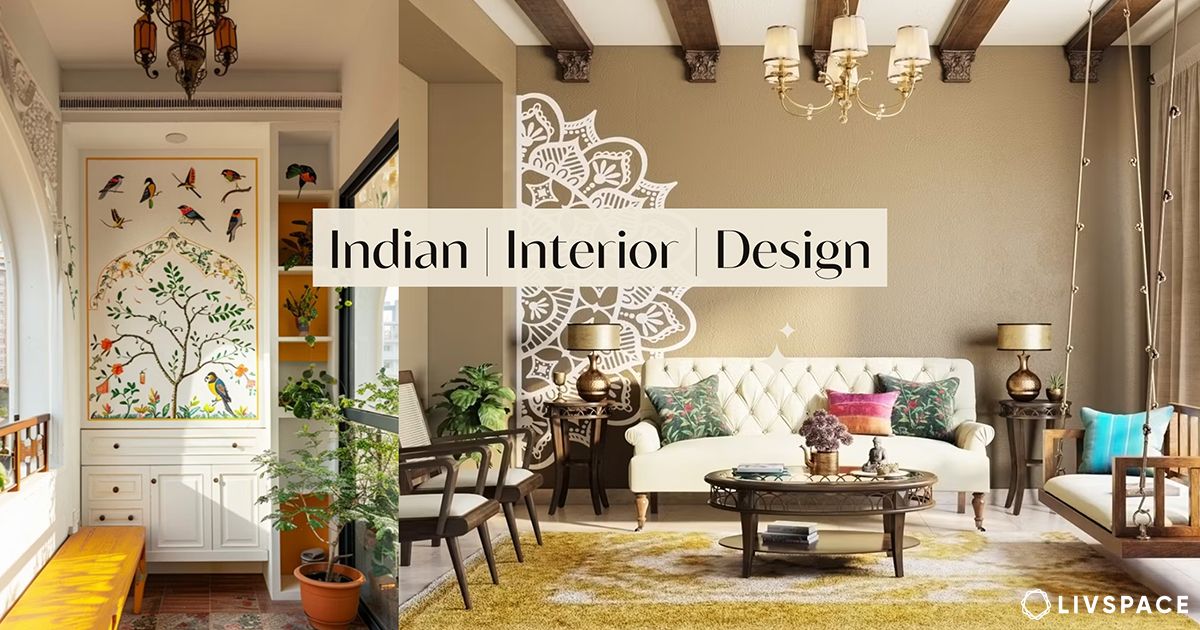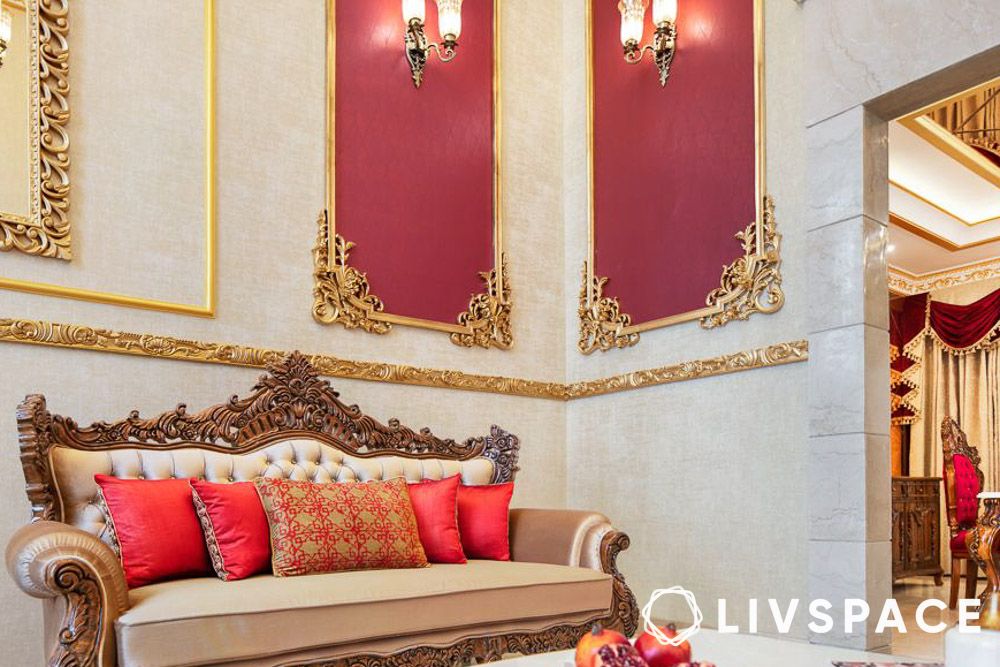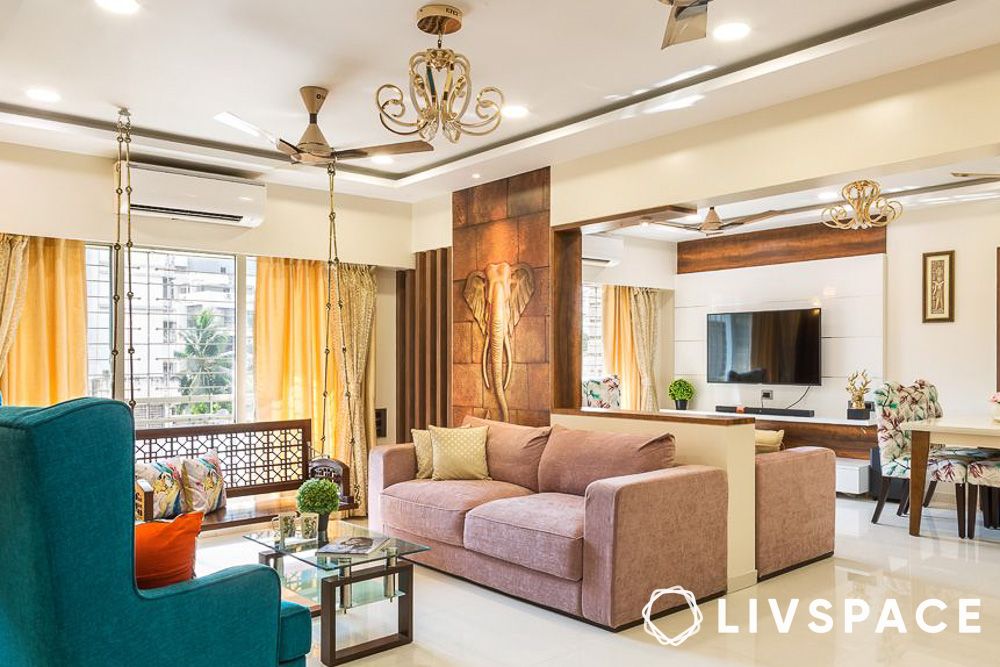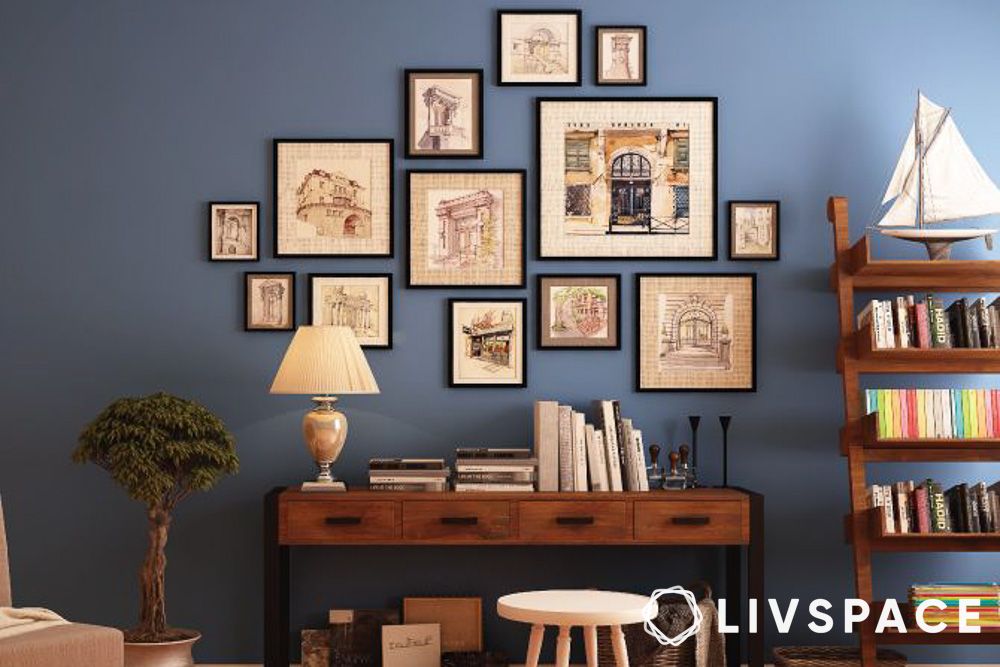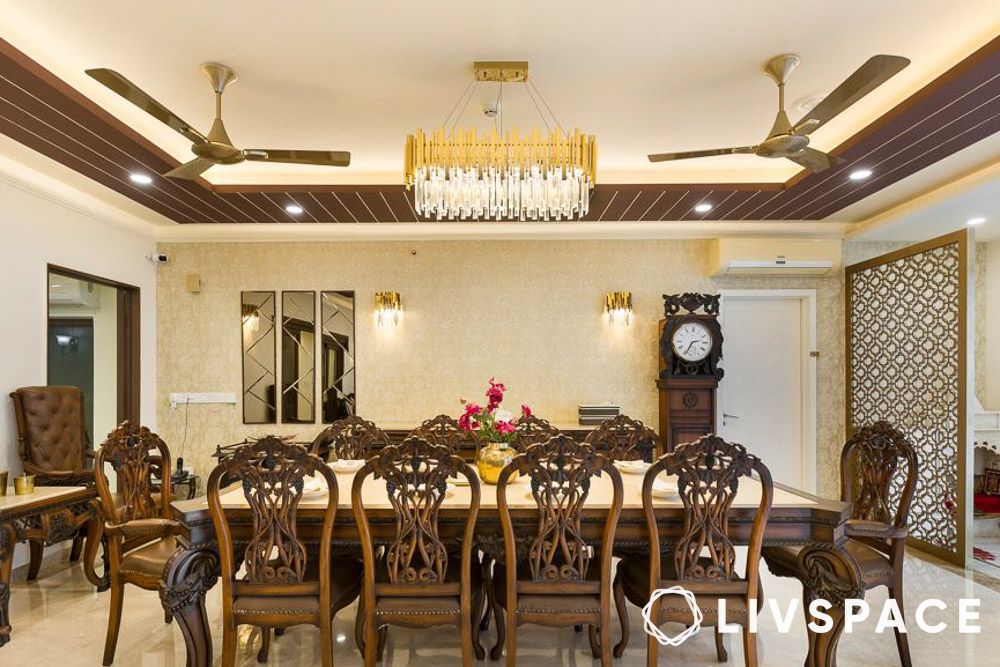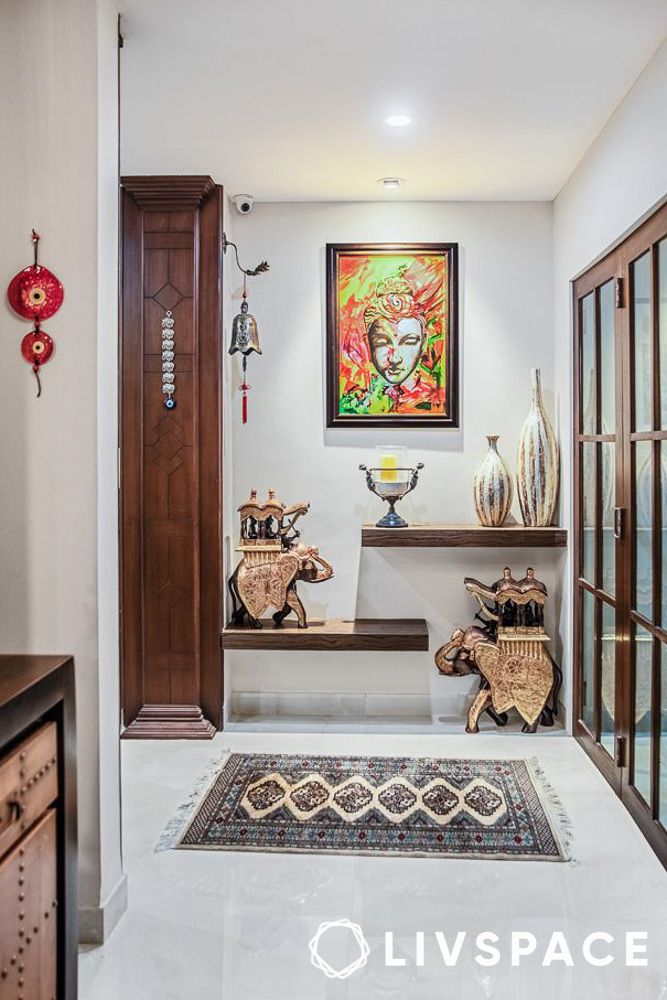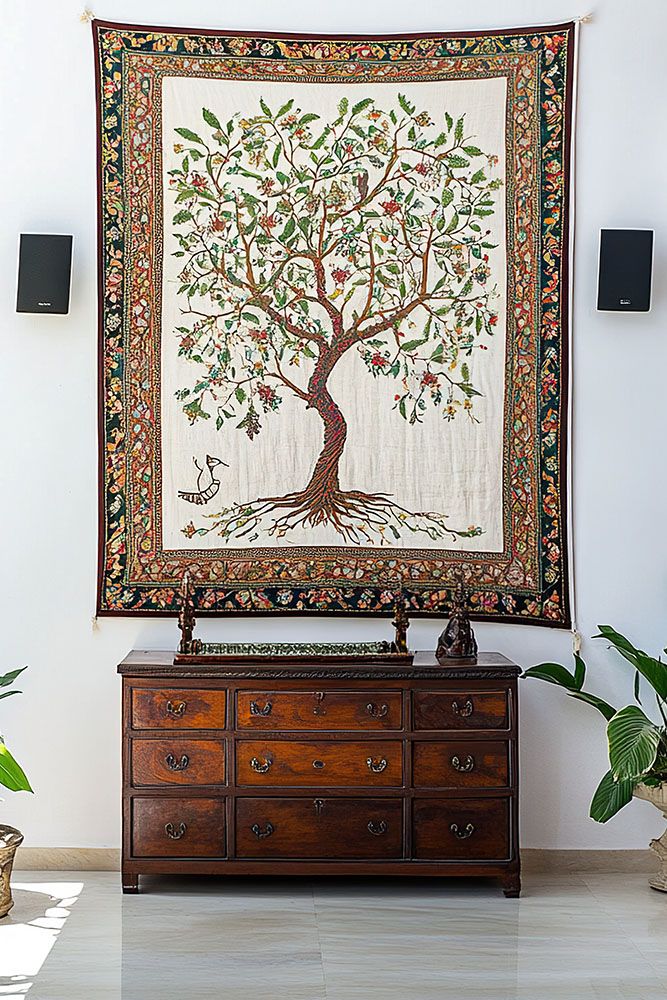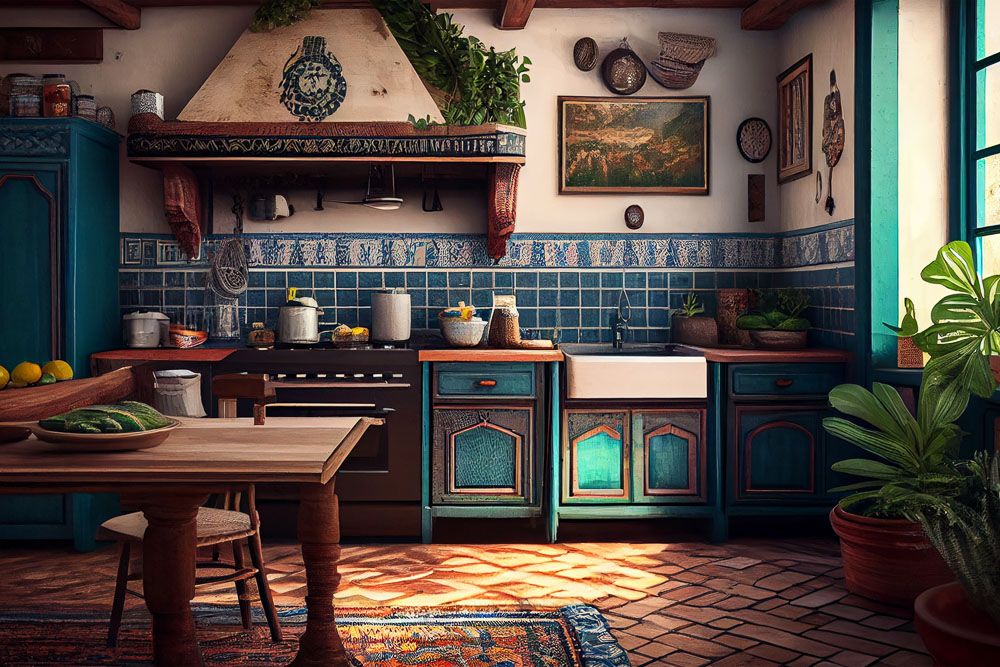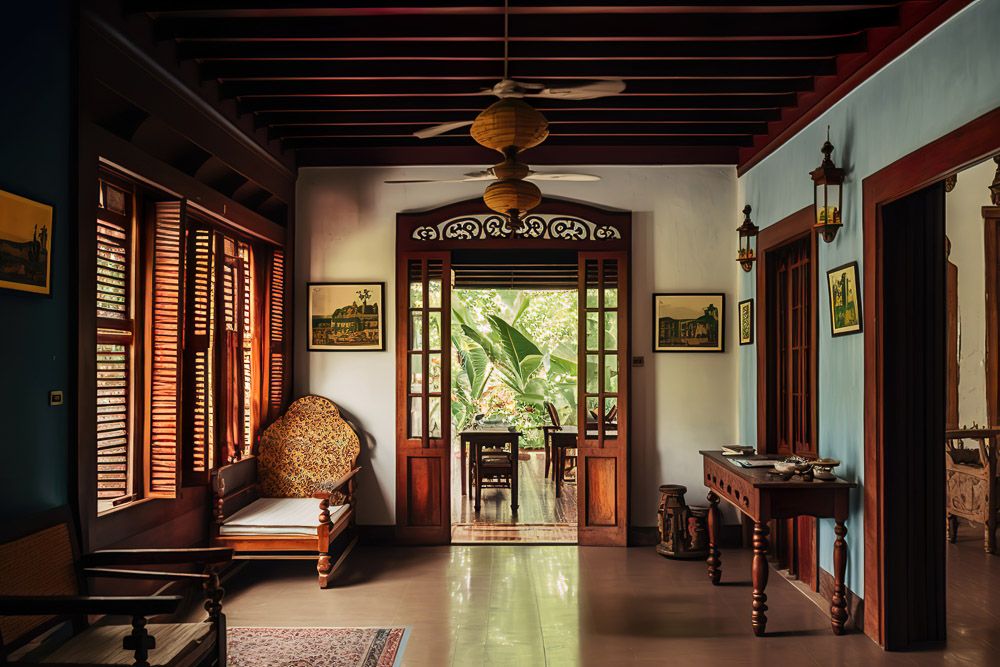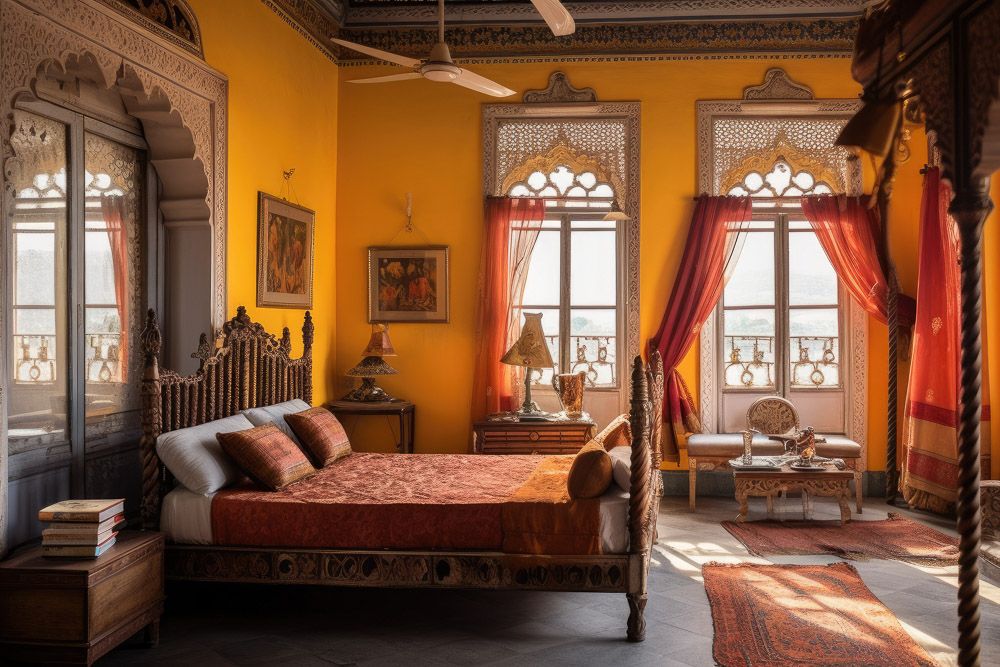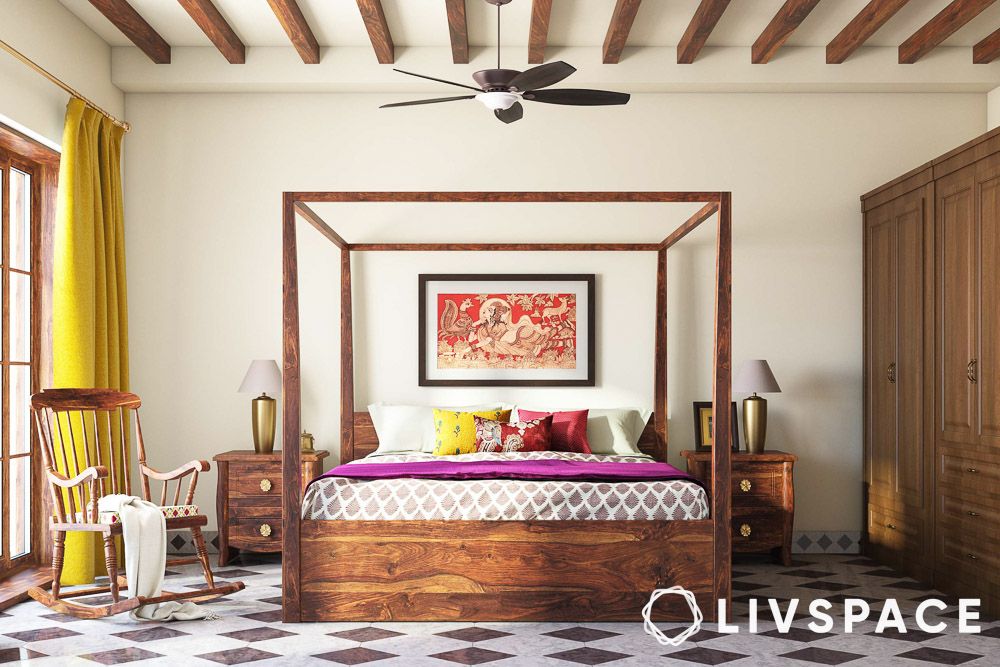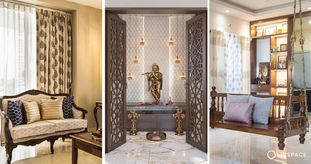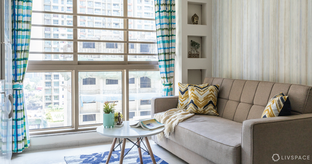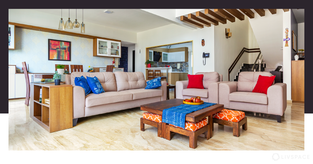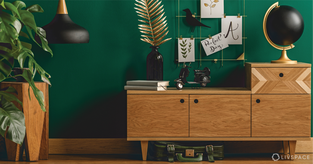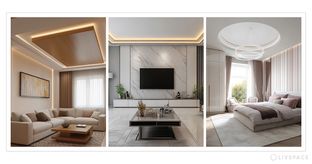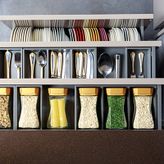In This Article
- #1: Be generous with vibrant colours for your Indian home design
- #2: Nothing matches the Indian interior style of solid wood furniture
- #3: Think inlays and carvings for a quick Indian interior style
- #4: An Indian home design must have informal spaces for family gatherings
- #5: Fill up nooks and niches with curios and knick-knacks
- #6: Use fabrics with desi prints and patterns for soft furnishings
- #7: The quintessential pooja room must have a place of honour in your Indian home design
- #8: Fill up the walls with folk art forms
- #10: Perfect outdoor spaces
- #11: Kids’ room with a desi touch
- #12: Add some desi glamour to your bathroom
- #13: Authentic and colourful patchwork for your Indian home design
- #14: Reuse some traditional Chettinad furniture
- #15: Sacred plants to keep your home blessed
- #16: The beauty of Indian arches and pillars
- #17: The trio to ace Indian interior design style
- #18: Mandala designs are more than just art
- #19: These home decor ideas are the unsung heroes of Indian home design
- PRO TIP: Jazzing it up with jaalis!
- The ultimate gallery of Indian home design inspirations
- How can Livspace help you?
Indian interior design—like everything else that is Indian, is steeped in a rich potpourri of culture. It is a style that comes down to us from our history with mixed influences. Be it temple motif architecture from down south or the intricate carvings seen on Mughal monuments, Indian interior design draws heavily from all these sources. In the end, what we have is a style that is just as composite as our culture!
But don’t let the complexity and evolution of the Indian interior design style overwhelm you. Implementing these is simpler than you think. All you need are some pro tips that will add a desi vibe to your home.
#1: Be generous with vibrant colours for your Indian home design
Bright and varied colours are the hallmarks of Indian interior design. While it’s hugely tempting to go crazy with such a vast palette, too much colour can create visual chaos.
- Opt for earthy tones – ochre yellows, rich browns and burnt oranges for your walls and floors
- Yellows and pinks on the fluorescent side of the spectrum and startling blues and greens can be used for smaller elements such as pillowcases or chairs
- You can also opt for a safe, bicolour theme – using a neutral shade as a base colour and bursts of peppy primary colours for accents
Check out this traditional Indian home design from #LivspaceHomes:
#2: Nothing matches the Indian interior style of solid wood furniture
Solid wood furniture is an important element in Indian interior design that reflects our royal nostalgia. For an authentic look, make the most of stunning Indian craftsmanship and choose traditional pieces with curved armrests and legs, carvings and inlay work in metal or ivory.
Get some ornate centrepieces and complement them with other more understated furniture. There’s a vast variety of distinctively Indian pieces to choose from such as wooden chests, footstools, jharokhas and birdcages.
Everything really comes down to the quality of the wood, so make sure you know about these 6 popular types of wood and where to use them.
#3: Think inlays and carvings for a quick Indian interior style
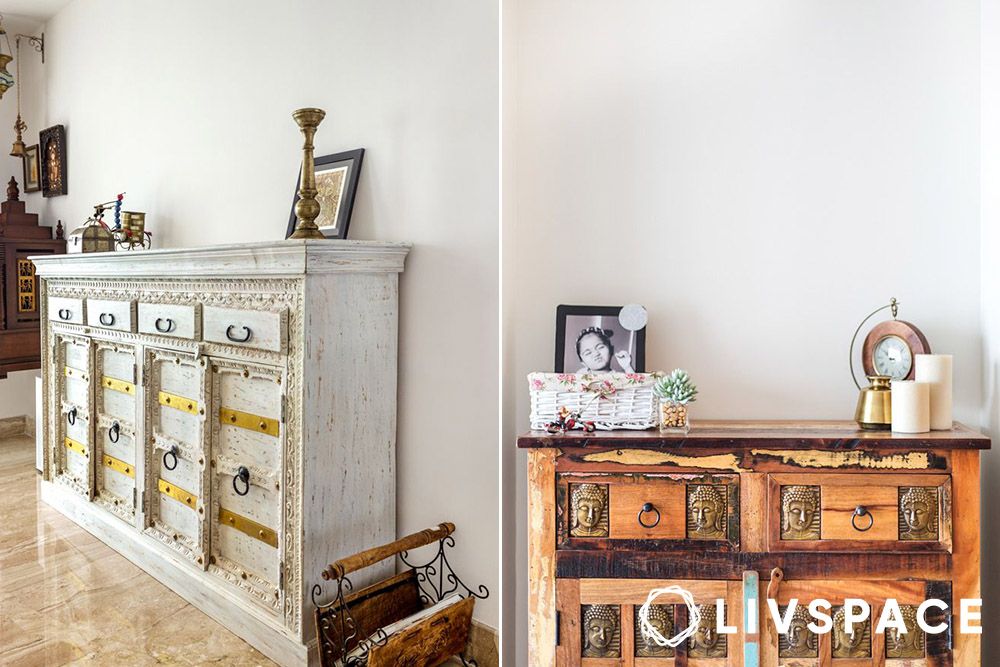
Traditional Indian cabinets combine functionality and aesthetics. Brightly painted and embellished with inlay work using mirrors, stones, ivory, or metal, they can also serve as storage units. Use them as accents alongside solid wood pieces to lighten the mood of your spaces. If you have heirloom furniture pieces, hold on to them and put them to good use.
“The entire world is in a transitional phase and so is the design industry. Infusing Indian heritage, art pieces, sculptures, and yarns, have been the most observed across the world. Incorporating an Indian element or material in design makes the space intriguing and beautiful both.”
– Ashmita Banerjee, Livspace interior designer
#4: An Indian home design must have informal spaces for family gatherings
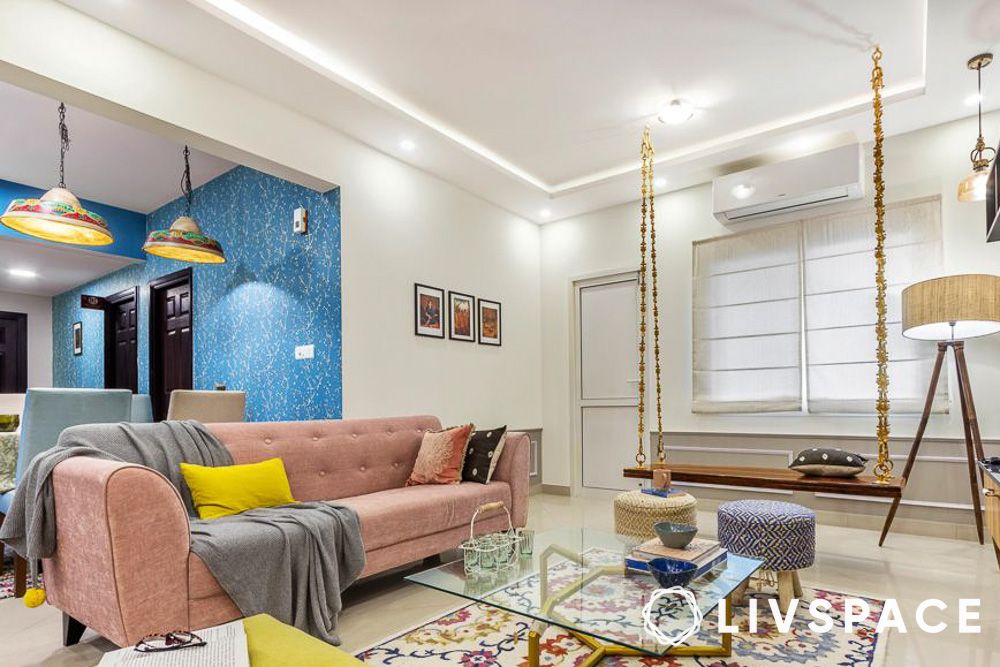
Indian homes also include versatile, informal spaces that allow relaxed interaction. Create different levels of seating using high chairs, sofas, divans and footstools. Rugs and floor cushions lend warmth and comfort to decor and can be used liberally. Traditional Indian pieces such as the swing, or jhoola, can bring a playful vibe to Your Indian style living room design that allows families to come together. You can actually swing it in style with these different types of swings!
#5: Fill up nooks and niches with curios and knick-knacks
Since India has a large and exciting variety of handicrafts, there are a ton of artefacts to choose from to decorate your home. Popular Indian home decor includes masks, clay pottery, diyas, leather puppets, crockery, and decorative boxes in sandalwood, metal or marble. You can also use brass lamps and pots as functional metallic accents.
#6: Use fabrics with desi prints and patterns for soft furnishings
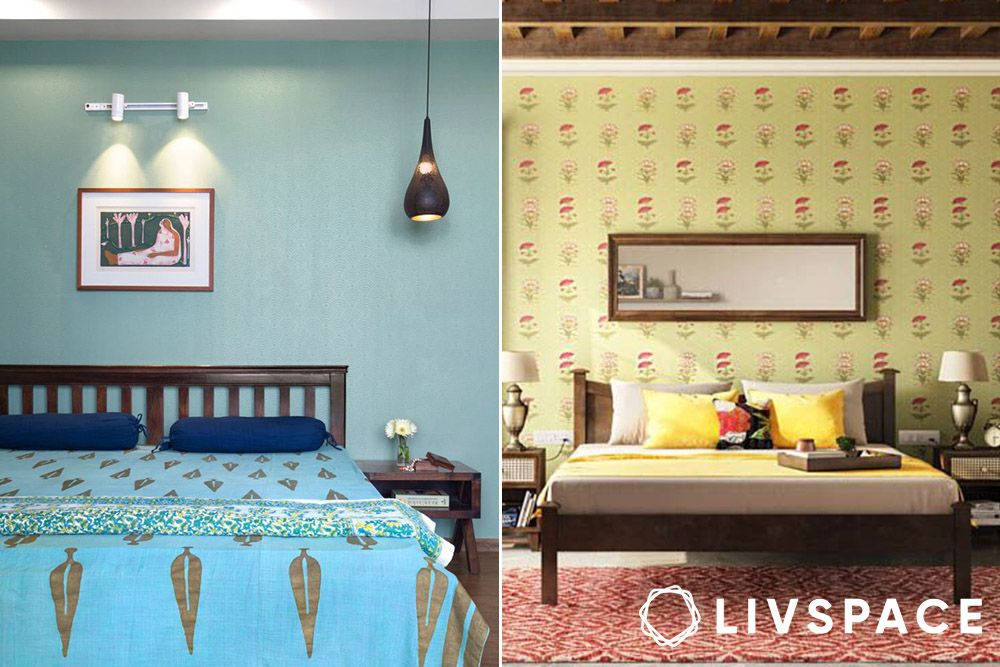
India is historically famous for its beautifully made fabrics. Moreover, these fabrics can be used in a number of creative ways in our homes – long, flowing drapes for windows, simple sheets thrown over a divan, carpets and dhurries.
As a part of using Indian interior design, use fine fabrics with dabu or ikat prints for upholstering your centrepieces or for your cushions. Cotton and khadi can be used for side chairs while simpler fabrics like jute can be used for smaller footstools.
Take a look at all the Indian prints that you can flaunt.
“Adding Indian cultural elements to your home is sure to amp up your aesthetics. Each region of India has its own special culture to offer; the design language of Gujarat is vastly different from that of Kerala. Don’t be afraid to splash out India’s vibrant colours as this is unique to the Indian heritage and you won’t find this anywhere else. Unity in diversity; that’s India and that’s Indian design.”
– Payal Bagzai, Livspace interior designer
#7: The quintessential pooja room must have a place of honour in your Indian home design
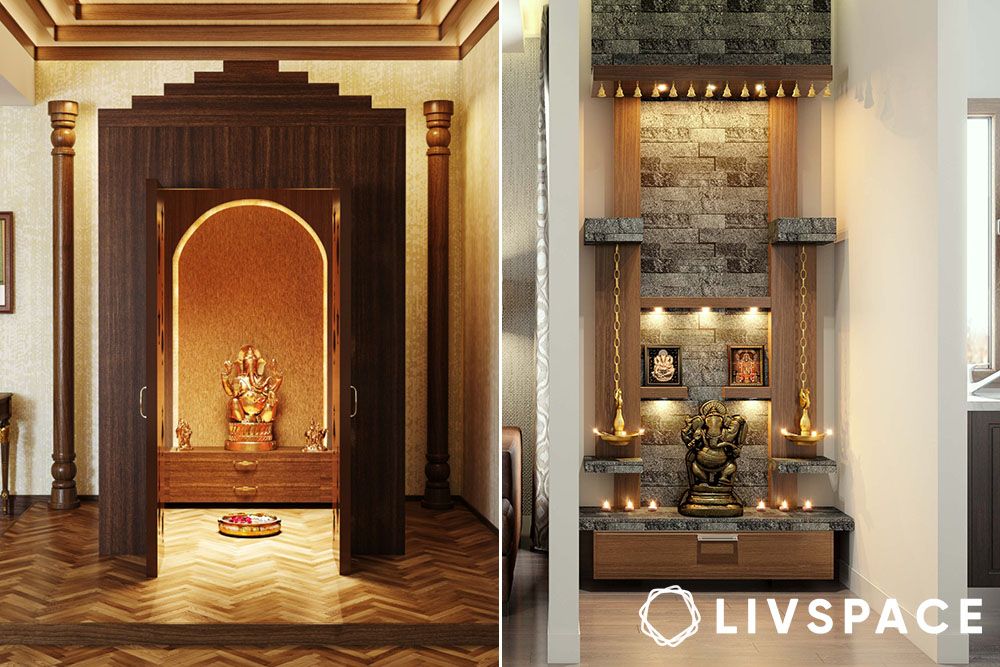
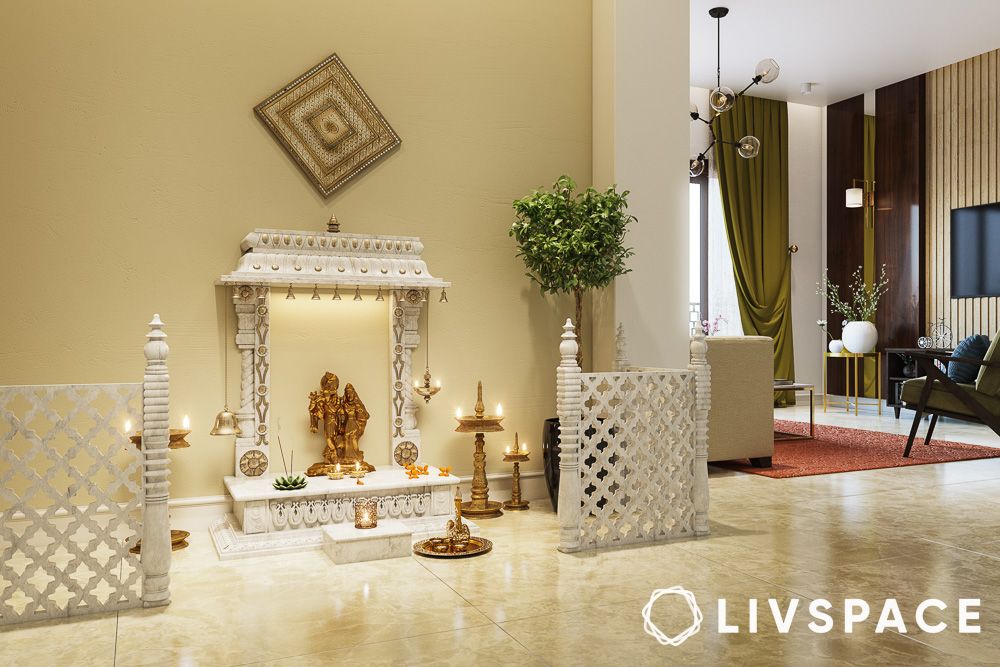
A place of worship within the house is a typical feature of the Indian interior design style. We usually do this in the form of altars or pooja rooms. It is advisable to keep home temple designs as traditional as possible so use either stone (marble or granite) or wood. Check out our marble mandir designs and wooden home temples!
#8: Fill up the walls with folk art forms
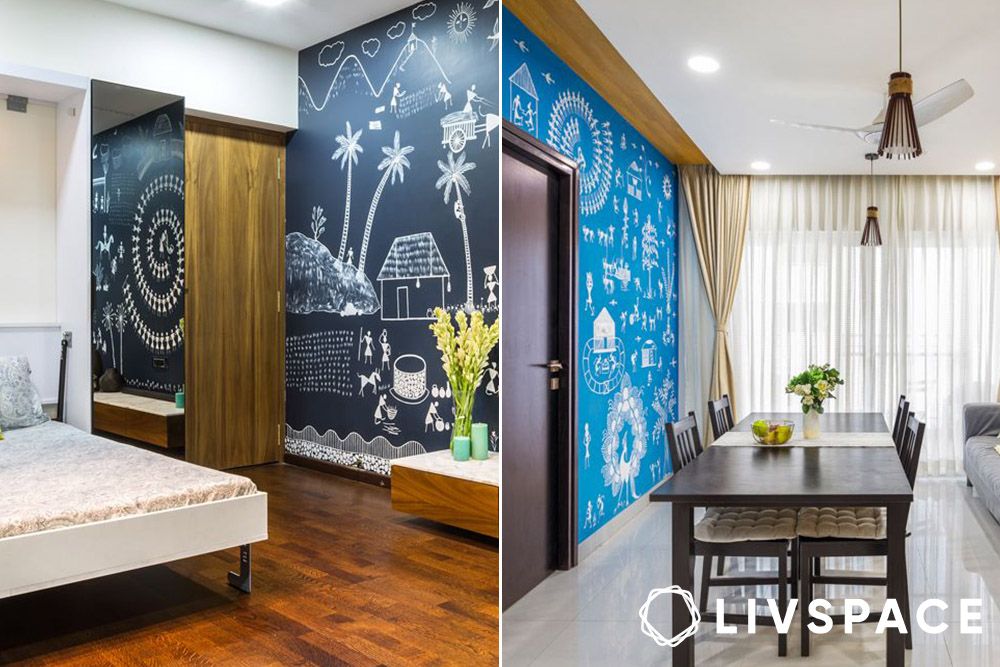
They say that the flavour of food changes every 50 km in India. And the rule applies to local art as well. Whether it is the Warli paintings from Maharashtra or Madhubani art from Bihar, there is no end to the options you have. When we have such a wealth of traditional art forms, why not put them to good use while doing home interiors? You can support local artists by having a statement wall painted by them or pick a wallpaper with these desi motifs.
Also Read: Wallpaper Designs: Spruce Up Your Walls with These 38 Fresh Patterns
#10: Perfect outdoor spaces
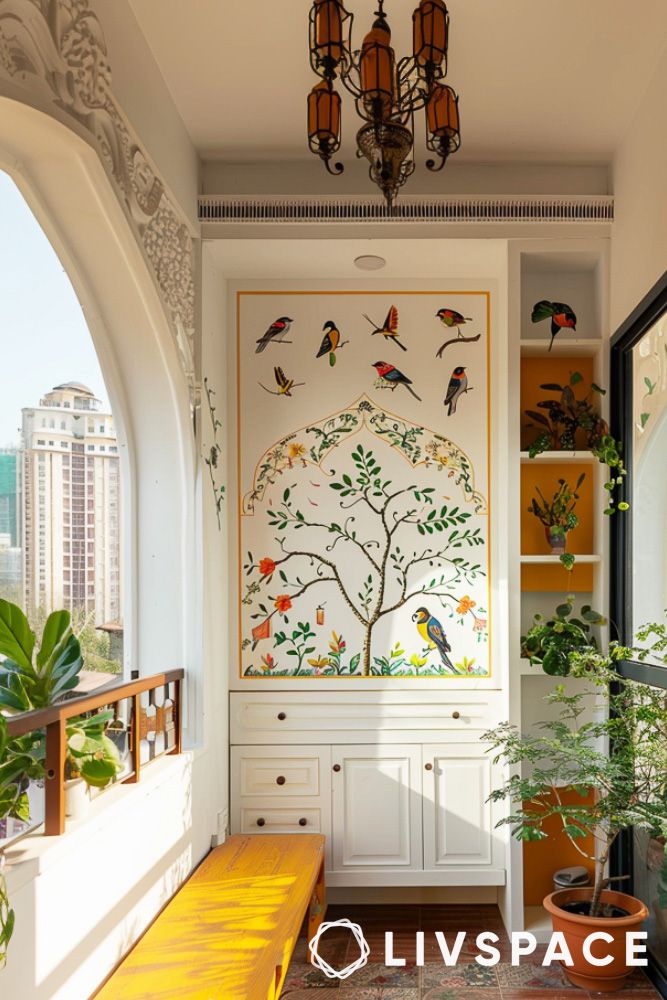
Fancy curling up with your favourite book in peace and tranquillity? Well, let’s do it the desi way, shall we? A common myth is that larger spaces can be designed and decorated well, but that is not the case. Small spaces like balconies can create wonders, too! Just add some greens and browns; and no, we don’t mean trees. Go for some rustic patio furniture with pops of colour. You can also use wicker chairs instead of foldable wooden chairs depending on what fits best. Throw in some printed cushions, a classic Indian throw, and a few potted plants and voila! Your personal chill zone balcony design is ready.
#11: Kids’ room with a desi touch
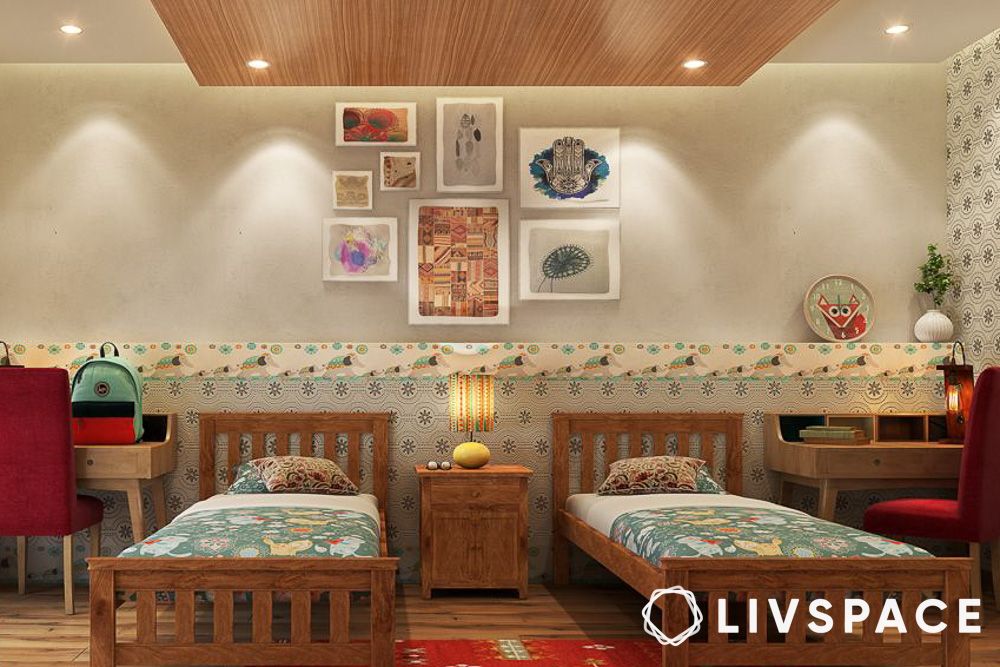
Children are lively, happy and vivacious little humans. So, colour is definitely an attractive quality for them. Splash out all the colours, prints and fabrics you can get your hands on for a kids’ room design. And since kids grow out of style with age, we recommend you stick to easily replaceable items in the room. This can be anything from an Aztec handicraft-printed rug, to jute blinds, or block-printed curtains. You can even change the sheets periodically with Jaipur prints or have paisley wallpaper.
#12: Add some desi glamour to your bathroom
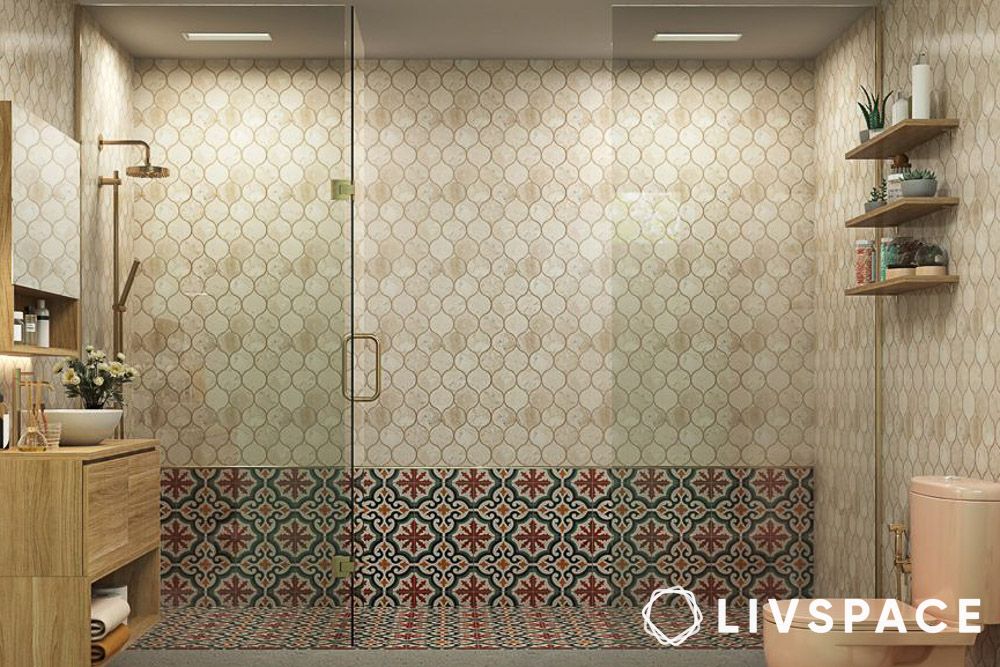
Surprised? Go desi for the bathroom design with some Indian printed tiles. Mixing and matching different patterns and shapes is also a good restroom tile idea. To provide a good contrast, pick one bold tone and make sure the other is a relatively muted tile colour. Hand-painted tiles are also easily available in the market. Additionally, you can add a traditional wooden vanity with cabriole legs to store your bath essentials.
Also Read: 40+ Stunning Floor Tiles to Transform Your Bathroom
#13: Authentic and colourful patchwork for your Indian home design
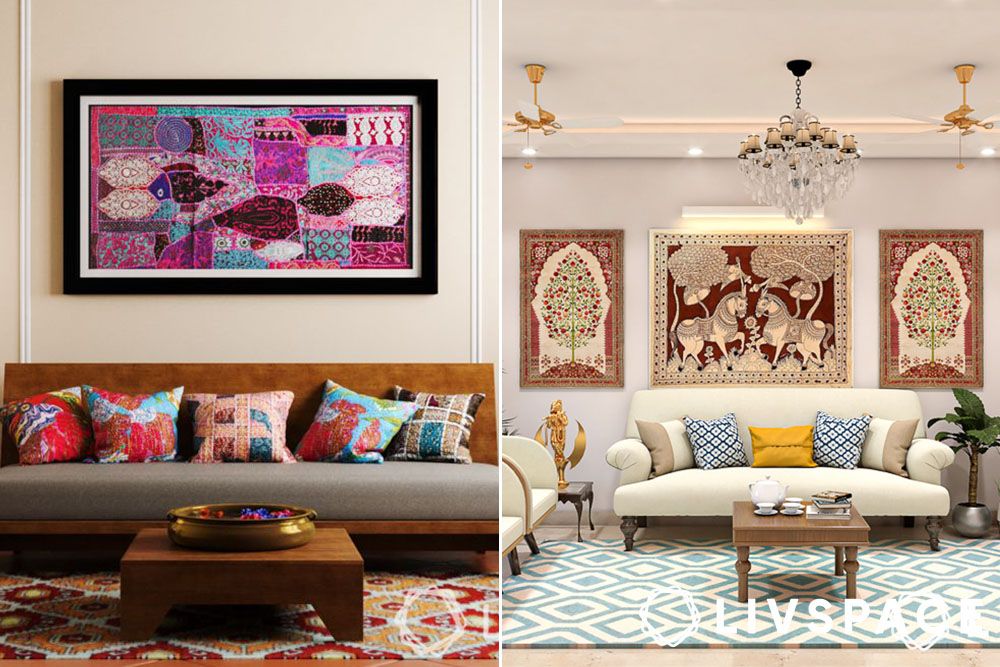
If you want to add that extra zing to your home interiors, patchwork is the way to go. These soft furnishings come in a wide range of colours and when stitched together, form unique and trendy designs. Patchwork is popularly used for soft furnishings like carpets, cushion covers and tapestries. Just frame a patchwork fabric and ta-da, you have your statement wall ready.
Traditional Indian ornamental pieces can be used to accentuate spaces. Indian interior design style is a vast arena to explore. Adding Indian motifs to bedding or curtains and traditional cut-work for mandir designs makes everything authentic to India and its cultural background.
#14: Reuse some traditional Chettinad furniture
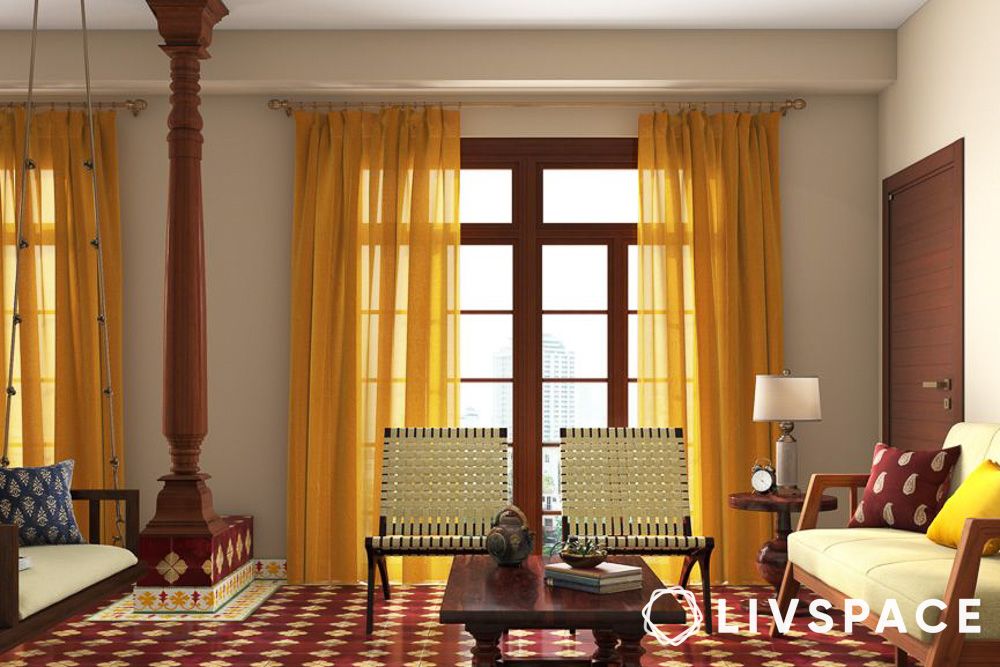
Savour in the earthy richness of this Chettinad house design. Originally, Chettinad furniture is made of teak and the chairs are intricately woven with cane. Teak wood has high durability and is ideal for humid climatic conditions. For this reason, teak wood is reused from old mansions as furniture. What accentuates this furniture even more is the addition of brass accents such as the handles of the swing, brass floor lamps and hanging lamps.
#15: Sacred plants to keep your home blessed
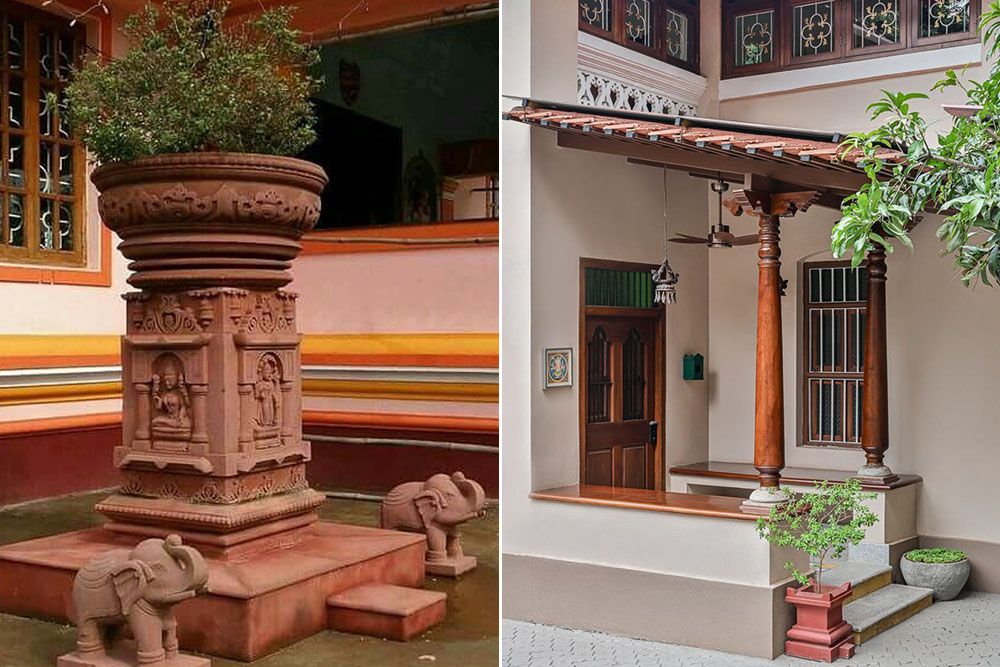
Like a room isn’t complete without a book, a home isn’t complete without a plant. It’s always beneficial to have a variety of plants in your home, be it indoor or outdoor plants. Having a tree in your home might not always be feasible, but you can keep a small tulsi mandir or some lotus plants instead to bring a positive flow of energy into your home.
Also Read: Plants Vastu Shastra: To Have or Not To Have at Home?
#16: The beauty of Indian arches and pillars
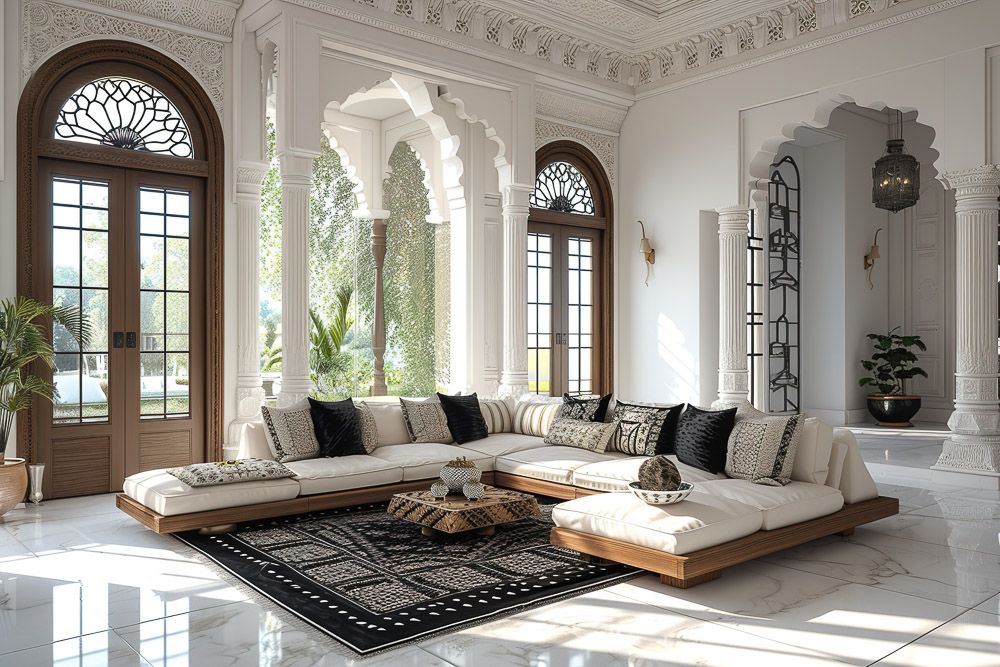
Nothing’s more regal than intricately carved arches and pillars in the Indian interior design style. The intricate details, often inspired by mythological stories or religious motifs, can create a sense of awe and wonder. And when paired with open-layout living areas like the one shown above, you totally nail the art of Indian interior design.
#17: The trio to ace Indian interior design style

Athangudi tiles are a beautiful and distinctive feature of South Indian interior design. Their vibrant colours, intricate patterns, and enduring durability make them a popular choice for flooring, walls, and even ceilings. Athangudi tiles are also a great choice for bathrooms, as they are resistant to moisture and easy to clean.
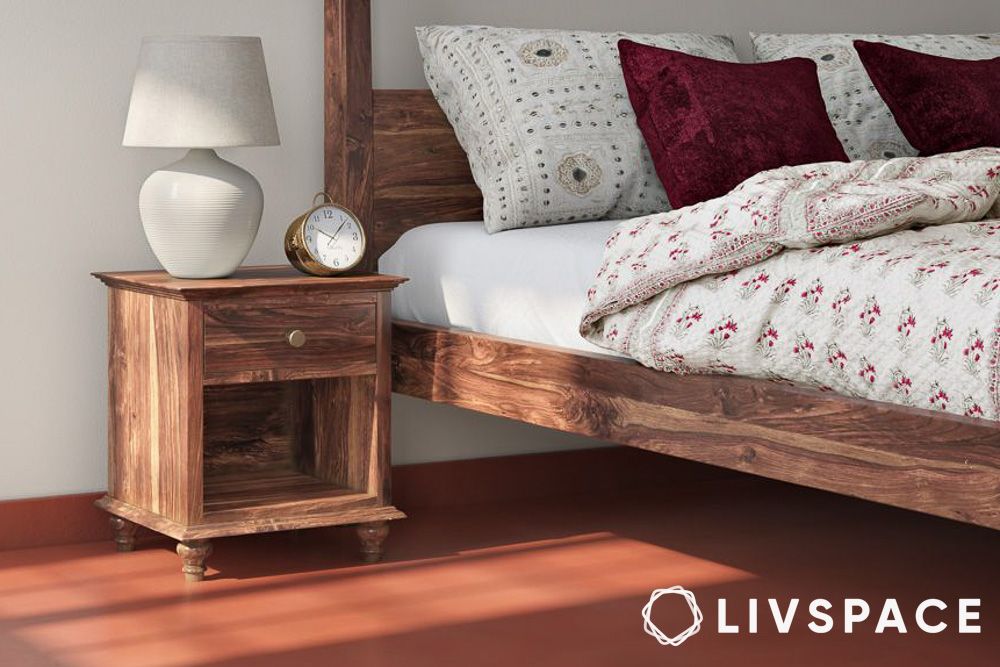
Red oxide flooring is super comfortable to walk on, especially if you’re barefoot. They’re not as hard as other materials like marble or tiles, so they’re easy on your knees and feet. Plus, they have a smooth, seamless finish that looks really cool and modern.
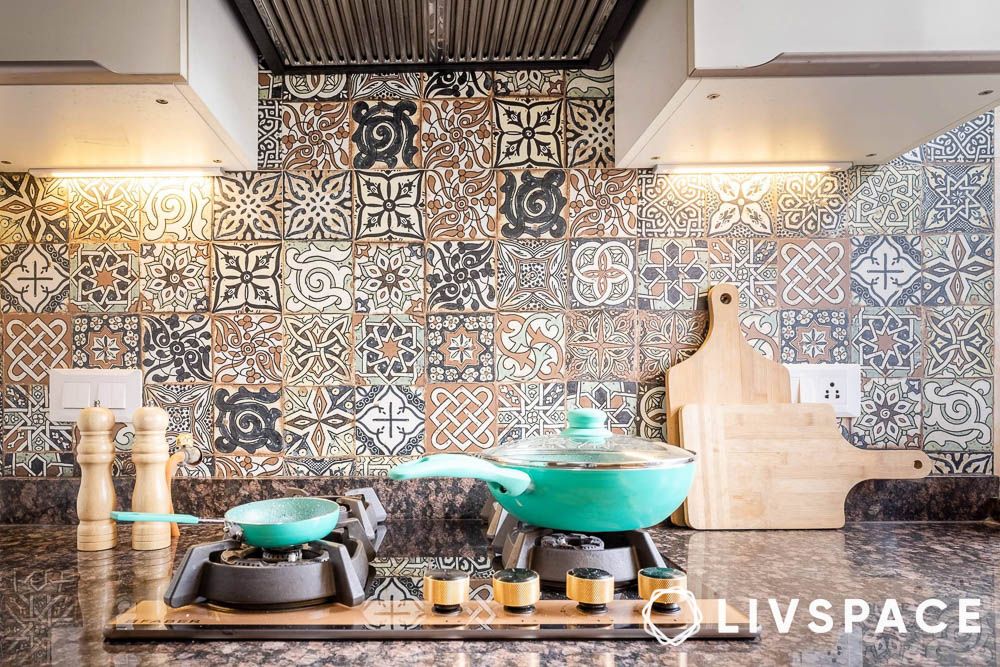
A glass mosaic backsplash is a total game-changer for your kitchen! It’s like adding a piece of art to the space. And the best part? You can totally customise it to match your style. Trust me, your future self will be so happy you went with a glass mosaic backsplash.
#18: Mandala designs are more than just art

Mandalas, originating in India around the first century BCE, are circular designs often used as meditation aids. There are three primary types of mandalas: sand mandalas, known for their intricate patterns created from coloured sand; healing mandalas, believed to promote physical and emotional well-being; and teaching mandalas, which convey spiritual or philosophical concepts through their symbolism. They stand for unity and wholeness, so they’re believed to bring balance and harmony into your life.
#19: These home decor ideas are the unsung heroes of Indian home design
Folk art
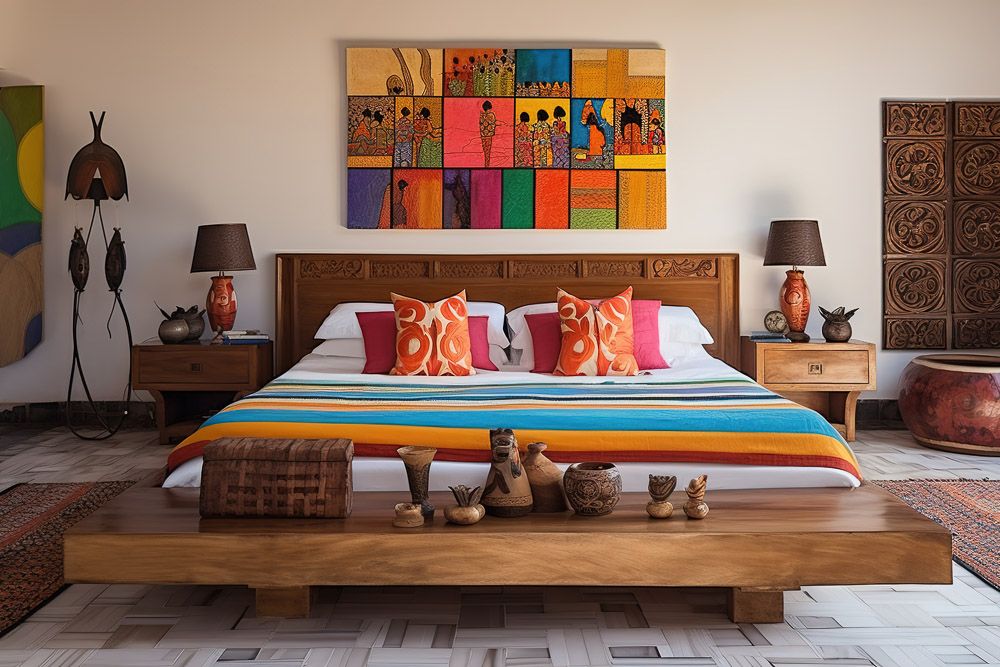
Folk art is a form of artistic expression that often serves both decorative and utilitarian purposes. It can be used in everyday life or reserved for special occasions and ceremonies. Folk art is typically handmade, although it may incorporate new, synthetic, or recycled materials.
Also Read: 50+ Inspiring Indian Bedroom Decor Ideas to Steal This Season
Vintage flower vases
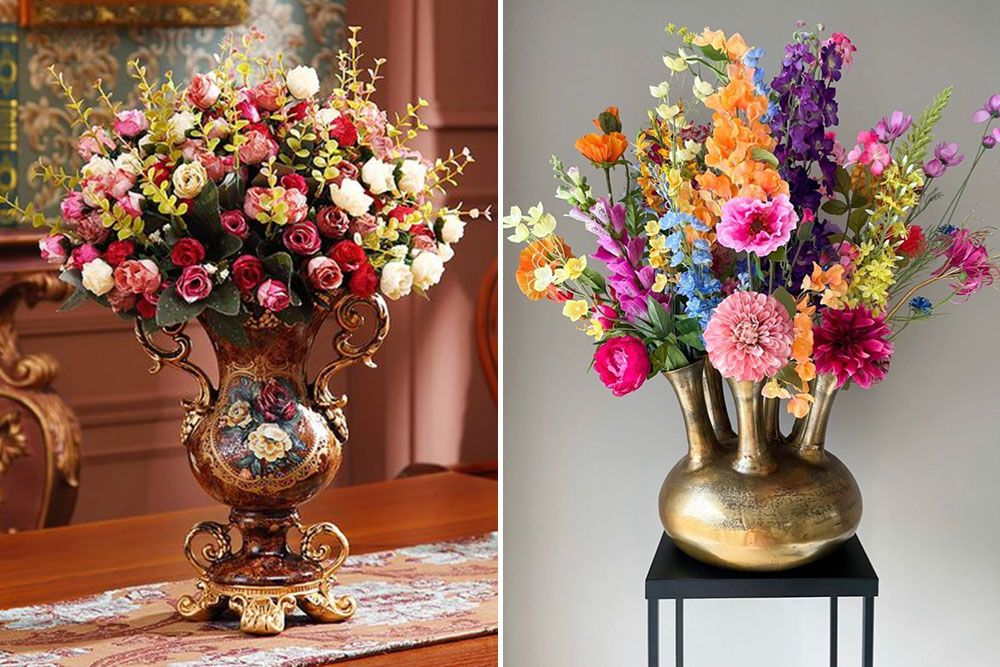
Antique flower vases, crafted from a variety of materials such as ceramic, glass, or metal, often feature intricate hand-painted motifs, delicate floral patterns, or subtle imperfections that tell a story of their rich history. To ensure you acquire a genuine antique, examine the bottom of the vase for markings like signatures, logos, symbols, or even numbers. These markings can provide valuable clues about the vase’s origin, age, and potential value.
Traditional antique mirrors
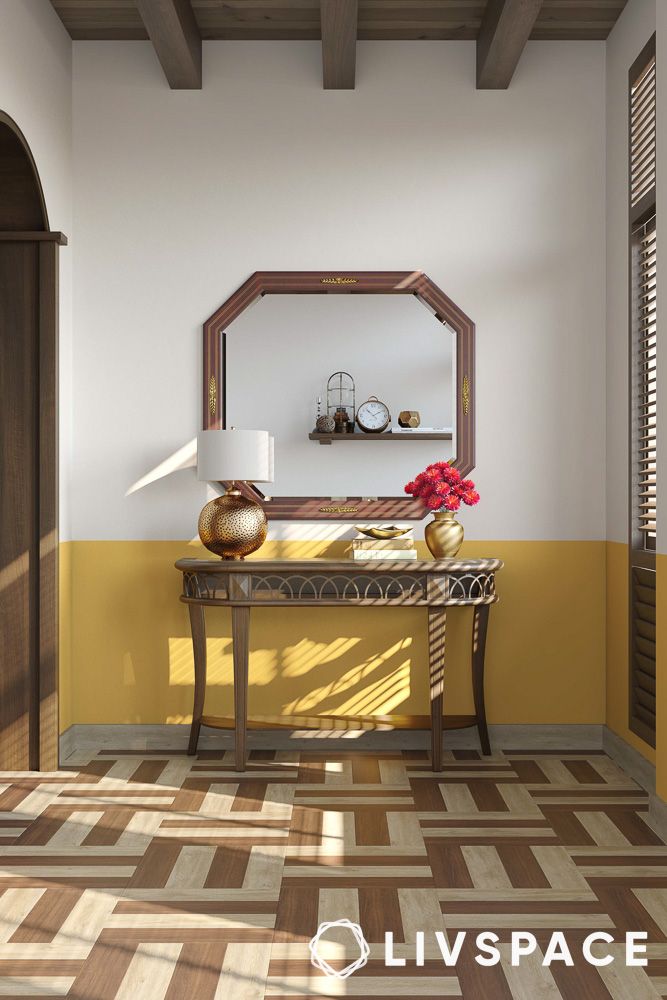
Vintage mirrors with wooden engraved frames and an equally antique-looking console table just bring together the whole Indian interior design theme. But how to identify an old mirror? Antique mirrors often exhibit signs of age, such as cloudy spots or blotches near the edges or across the surface. This discolouration occurs due to the oxidation of mercury over time.
Dhoop holders
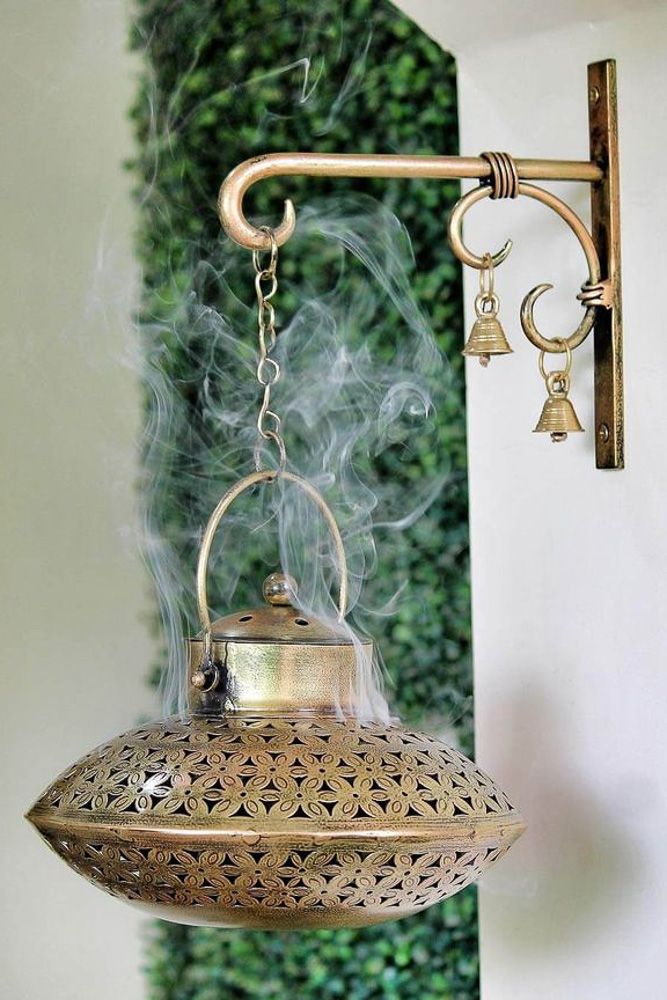
Image source: Pinterest @mangalfashions
Dhoop holders often feature intricate designs and carvings, inspired by Indian mythology, religious symbols, or natural motifs. These Indian house interior design elements can serve as a visual representation of Indian culture and heritage, adding a touch of authenticity and character to the interior.
Carved handles
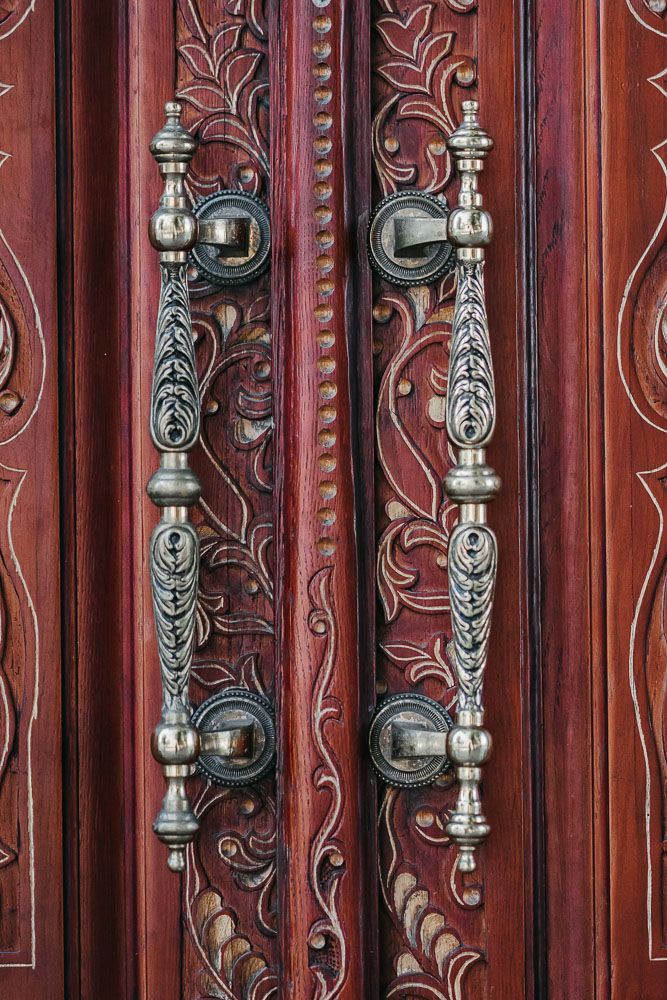
Handles can be designed to incorporate certain symbols or motifs that hold cultural importance. These Indian house interior design ideas can even be used to create focal points within a room. For example, a pair of large, ornate handles on a cabinet can draw the eye and add a sense of drama.
Ceramics and pottery
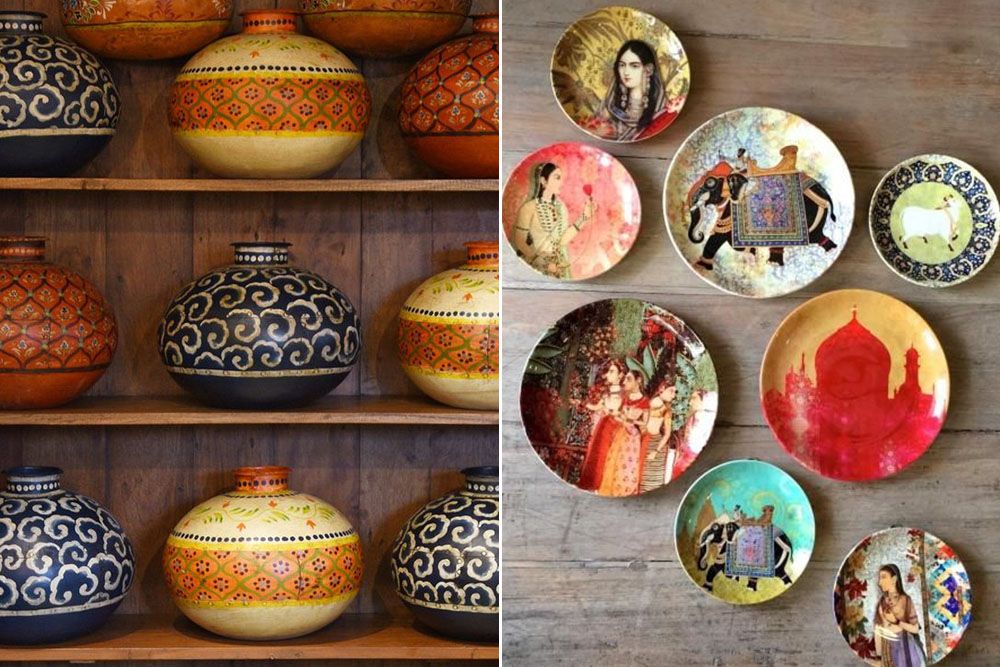
Image source: Pinterest @indigoantiques and Instagram @morataara
Pottery and ceramics have been integral to Indian culture and society for millennia. Different regions of India have their own unique pottery traditions, reflecting local cultures, materials, and techniques. For example, the blue pottery of Jaipur, Rajasthan, is famous for its intricate designs and vibrant colours. This means you are spoilt for options!
PRO TIP: Jazzing it up with jaalis!
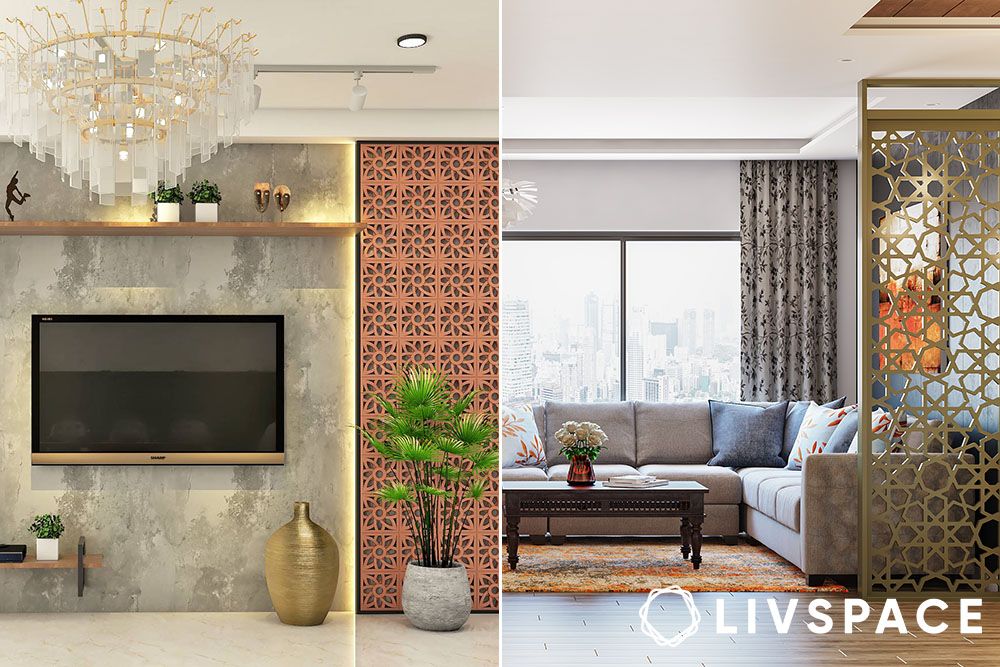
The quintessential jaali pattern is more than just a passing trend. In fact, it has survived and evolved over centuries because it is a great combination of form and function. You can use jaalis in your home as partitions, doors, wall panels, pooja rooms, furniture and ceiling designs. Do not miss exploring the complete style evolution of jaali designs.
The ultimate gallery of Indian home design inspirations
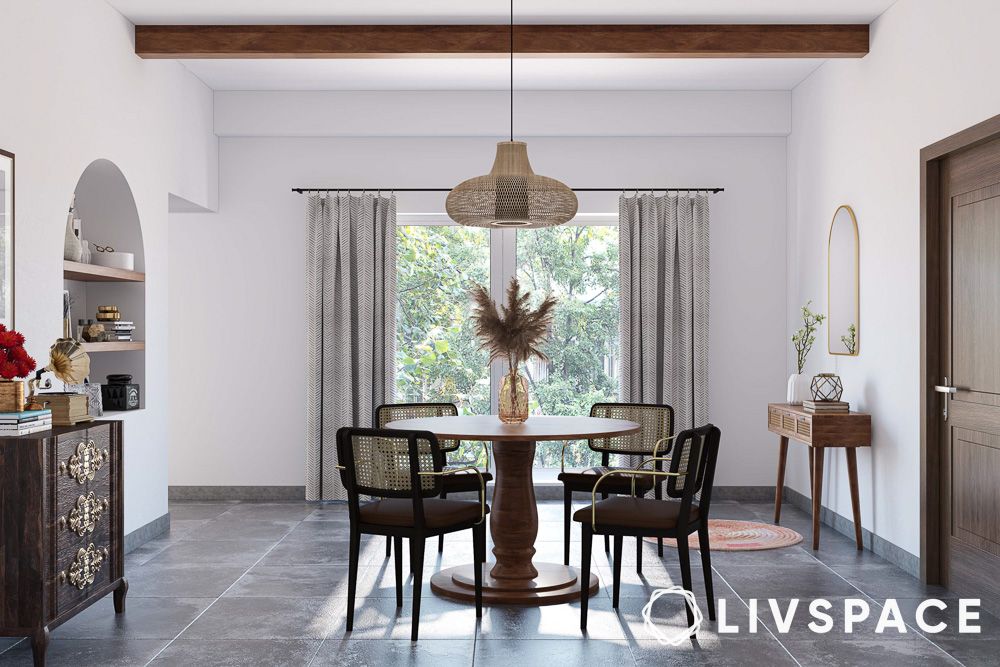
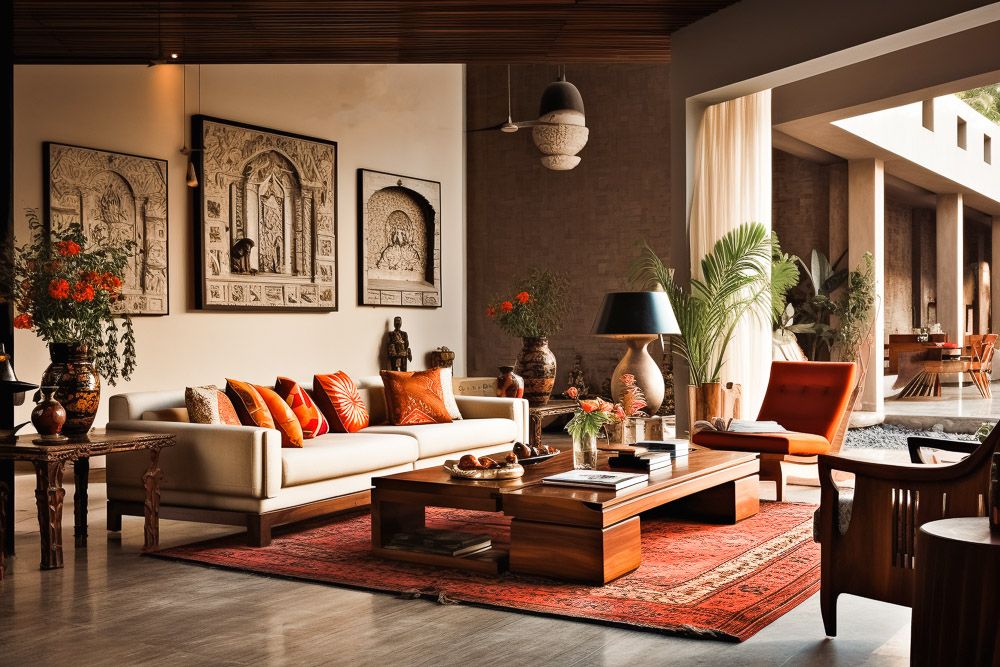
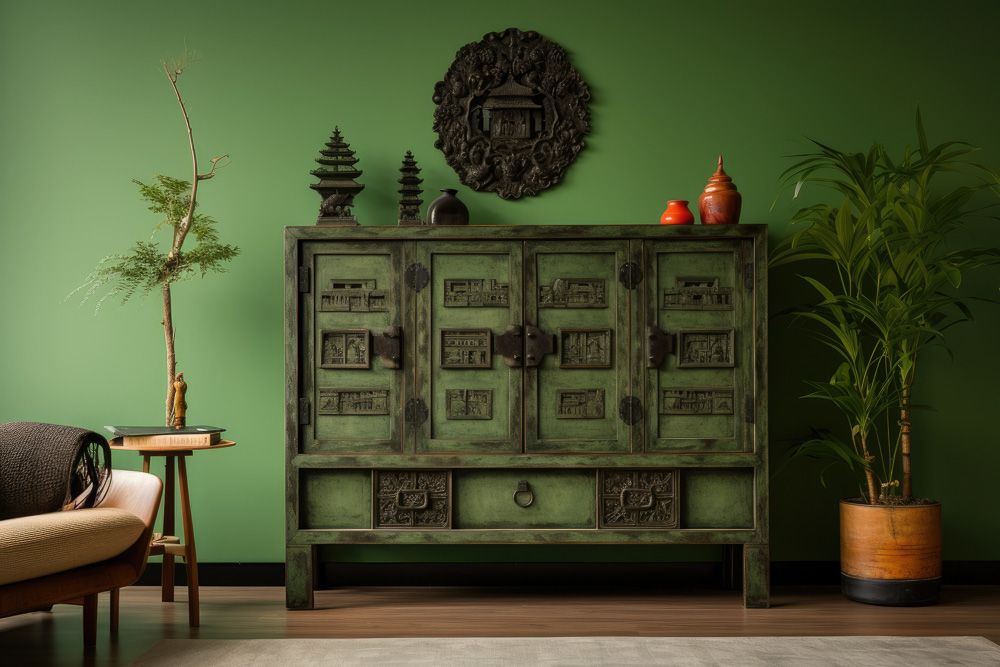
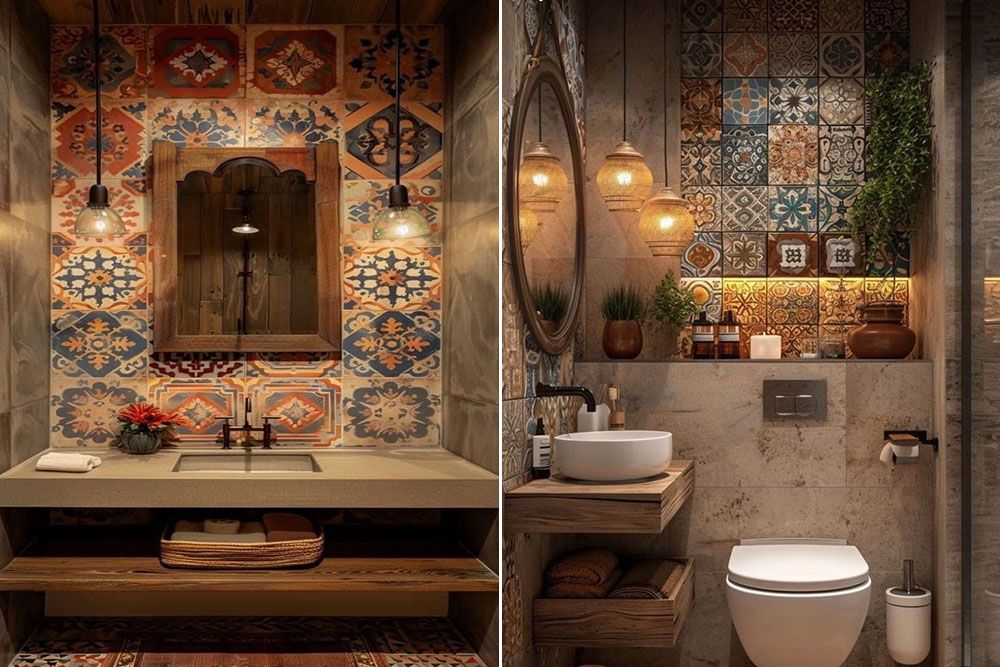
How can Livspace help you?
In love with these Indian house interior design ideas? Save it in your Pinboard and reach out to our designers to get customised 3D renderings for your dream home!
- We offer 146 quality checks on all our products
- You can avail of the flat 10-year warranty* and the easy EMI options
Let us help you create your dream home interiors along with the best materials! Book a consultation NOW!
*For select finishes on modular products. For full scope of warranty, please visit livspace.com/in/service
Disclaimer: All contents of the story are specific to the time of publication. Mentions of costs, budget, materials, finishes, and products from the Livspace catalogue can vary with reference to current rates. Talk to our designer for more details on pricing and availability. The Pinterest and Instagram images used in this blog are solely for illustrative purposes. We do not claim ownership of these images, and all rights belong to their respective owners. If you are the owner of any image and would like it to be removed or credited differently, please contact us.
